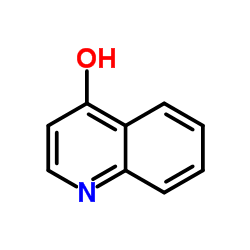4-quinolone

4-quinolone structure
|
Common Name | 4-quinolone | ||
|---|---|---|---|---|
| CAS Number | 611-36-9 | Molecular Weight | 145.158 | |
| Density | 1.3±0.1 g/cm3 | Boiling Point | 313.0±15.0 °C at 760 mmHg | |
| Molecular Formula | C9H7NO | Melting Point | 200-202 °C(lit.) | |
| MSDS | Chinese USA | Flash Point | 143.1±20.4 °C | |
| Symbol |

GHS07 |
Signal Word | Warning | |
|
Synergistic antidepressant-like effect of ferulic acid in combination with piperine: involvement of monoaminergic system.
Metab. Brain Dis. 30 , 1505-14, (2015) The lifetime prevalence rate for major depressive disorder (MDD) is approximately 17 % for most developed countries around the world. Dietary polyphenols are currently used as an adjuvant therapy to accelerate the therapeutic efficacy on depression. Ferulic a... |
|
|
Evolution from a natural flavones nucleus to obtain 2-(4-Propoxyphenyl)quinoline derivatives as potent inhibitors of the S. aureus NorA efflux pump.
J. Med. Chem. 54 , 5722-36, (2011) Overexpression of efflux pumps is an important mechanism by which bacteria evade the effects of substrate antimicrobial agents. Inhibition of such pumps is a promising strategy to circumvent this resistance mechanism. NorA is a Staphylococcus aureus efflux pu... |
|
|
Antioxidant properties of 4-quinolones and structurally related flavones.
Bioorg. Med. Chem. 20 , 809-18, (2012) Neurodegenerative disorders are frequently associated with increased oxidative damage to the brain as a result of free radicals produced by cellular respiration. The onset and progression of neurodegeneration may therefore be curbed by exogenous hydrogen-dona... |
|
|
5-(2-Aminopropyl)indole (5-IT): a psychoactive substance used for recreational purposes is an inhibitor of human monoamine oxidase (MAO).
Drug Test. Anal. 6(7-8) , 607-13, (2014) 5-(2-Aminopropyl)indole (5-IT) is a psychoactive compound that has recently been associated with several fatal and non-fatal intoxications in a number of European countries. There are indications that acute effects may include symptoms of monoaminergic (e.g. ... |
|
|
Selective formation of glycosidic linkages of N-unsubstituted 4-hydroxyquinolin-2-(1H)-ones.
Carbohydr. Res. 345(6) , 768-79, (2010) A comparative study for selective glucosylation of N-unsubstituted 4-hydroxyquinolin-2(1H)-ones into 4-(tetra-O-acetyl-beta-D-glucopyranosyloxy)quinolin-2(1H)-ones is reported. Four glycosyl donors including tetra-O-acetyl-alpha-D-glucopyranosyl bromide, beta... |
|
|
Difference in brain distributions of carbon 11-labeled 4-hydroxy-2(1H)-quinolones as PET radioligands for the glycine-binding site of the NMDA ion channel.
Nucl. Med. Biol. 35(2) , 203-12, (2008) High-affinity iodine- and ethyl-C-5 substituted analogs of 4-hydroxy-3-(3-[11C]methoxyphenyl)-2(1H)-quinolone ([11C]4HQ) were synthesized as new positron emission tomography radioligands for the glycine-binding sites of the N-methyl-d-aspartate (NMDA) ion cha... |
|
|
Antioxidative or prooxidative effect of 4-hydroxyquinoline derivatives on free-radical-initiated hemolysis of erythrocytes is due to its distributive status.
Biochim. Biophys. Acta 1570(2) , 97-103, (2002) 7-Chloro-4-hydroxyquinoline (CQ) is an antitumor drug but its efficiency is not very satisfactory. This fact motivates us to study the relationship between the structure of 4-hydroxyquinoline with various substituent and its antioxidant effect against free-ra... |
|
|
Synthesis of chromones and 4-hydroxyquinolines based on uncatalyzed condensations of 1-methoxy-1,3-bis(trimethylsilyloxy)-1,3-butadiene with 2-alkoxy- and 2-nitrobenzoyl chlorides and related reactions.
Org. Biomol. Chem. 7(9) , 1931-8, (2009) The reaction of 1-methoxy-1,3-bis(trimethylsilyloxy)-1,3-butadiene with 2-methoxybenzoyl chlorides afforded 3,5-diketoesters which were transformed, by treatment with boron tribromide, into functionalized 2-hydroxychroman-4-ones or chromones. The reaction of ... |
|
|
The effects of hydergine on the MAO activity of the aged and adult rat brain.
Eur. Neuropsychopharmacol. 5(4) , 527-9, (1995) Despite the fact that hydergine has been used in the treatment of dementia for many years, its mechanism of action is still not clear. Current studies imply that the major effect of hydergine may be the modulation of synaptic neurotransmission rather than sol... |
|
|
Experimental and quantum chemical study of photochemical properties of 4-hydroxyquinoline.
Photochem. Photobiol. Sci. 8(11) , 1550-7, (2009) UV irradiation of aqueous 4-hydroxyquinoline (4HQN) solutions results in the formation of the triplet states with the quantum yields 30%, 35%, and 7.5% in acidic, neutral, and basic solutions, respectively. In neutral solutions, the keto form is the major tau... |